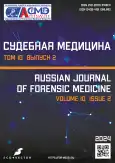Prevention of self-harm and suicide among persons serving sentences in minimum security correctional institutions of the penal enforcement system of the Republic of Kazakhstan
- Authors: Urazalin B.T.1, Begaliyev Y.N.1, Mukanov M.R.2, Imashev B.M.3
-
Affiliations:
- Academy of Law Enforcement Agencies Under the General Prosecutors Office of the Republic of Kazakhstan
- The Kostanai Academy of the Ministry of Internal Affairs of the Republic of Kazakhstan named after Shyrakbek Kabylbayev
- Eurasian Center for Economic and Legal Studies of Narxoz University
- Issue: Vol 10, No 2 (2024)
- Pages: 210-219
- Section: Original study articles
- URL: https://journals.rcsi.science/2411-8729/article/view/262745
- DOI: https://doi.org/10.17816/fm16084
- ID: 262745
Cite item
Full Text
Abstract
BACKGROUND: The article considers the possibilities of preventing self-harm and suicide among inmates in minimum security institutions of the penal and correctional system of the Republic of Kazakhstan. Statistics of the annual cases of self-harm and suicidal acts confirm the need to prevent them using psychological, technical, and legislative tools.
AIM: To determine the possibilities of preventing self-harm and suicidal acts among persons serving sentences in minimum security correctional institutions of the penal and correctional system of the Republic of Kazakhstan.
MATERIALS AND METHODS: An intellect map was used to visualize concepts. The following were used as tools for psychological diagnostics: questionnaires to establish the presence or absence of mental disorders and identify signs of potential suicide risk; sketch of a potential client’s persona to see the behavior, emotional state, daily activities, demographic characteristics, and needs and goals of the client; and thematic plan schedule of individual counseling meetings.
RESULTS: Autoaggression was most often singled out as the most relevant destructive form of behavior in correctional institutions of the penal system. To understand the phenomenon of autodestructive behavior, an intellectual map of this concept was presented, showing its specificity, spheres of its research and study, and types and highlighting the directions for the prevention of such behavior.
CONCLUSION: The implementation of the formulated proposals, as well as the control and coordination of activities to prevent self-harm and suicide among inmates by the management, was found to reduce these incidents. This will positively help eliminate one of the threats to the personal safety of convicts.
Full Text
##article.viewOnOriginalSite##About the authors
Bauyrzhan T. Urazalin
Academy of Law Enforcement Agencies Under the General Prosecutors Office of the Republic of Kazakhstan
Author for correspondence.
Email: baur.urazalin77@gmail.com
ORCID iD: 0009-0000-5368-1848
MD
Kazakhstan, KoshyYernar N. Begaliyev
Academy of Law Enforcement Agencies Under the General Prosecutors Office of the Republic of Kazakhstan
Email: ernar-begaliev@mail.ru
ORCID iD: 0000-0001-6659-8576
SPIN-code: 1929-3392
Dr. Sci. (Legal), Professor
Kazakhstan, KoshyMalik R. Mukanov
The Kostanai Academy of the Ministry of Internal Affairs of the Republic of Kazakhstan named after Shyrakbek Kabylbayev
Email: alik8385@mail.ru
ORCID iD: 0000-0002-4615-7666
SPIN-code: 2316-5222
Dr. Sci. (Philosophical)
Kazakhstan, KostanaiBerik M. Imashev
Eurasian Center for Economic and Legal Studies of Narxoz University
Email: berikmazhitovich@gmail.com
ORCID iD: 0009-0001-8760-9913
SPIN-code: 4888-0942
Cand. Sci. (Legal)
Kazakhstan, AlmatyReferences
- Kulakova SV, Novikov AV, Suslov YE. Theoretical and practical aspects of destructive conduct of concerned, related with self-aggressive mechanisms of implementation (on the example of certain finished and affective suicide). Psychology. Historical-Critical Rev Contemporary Res. 2018;7(1А):109–118. EDN: XQCDVB
- Nevolina OA, Guremina NV. Development of the project of psychological practice "Reducing the manifestation of autodestructive behaviour in convicts". In: Proceedings of the XV International Student Scientific Conference "Student Scientific Forum". (In Russ). Available from: https://scienceforum.ru/2023/article/2018032412. Accessed: 27.05.2024.
- Tursunov AB, Galitsky FA, Begaliev EN, et al. Forensic and forensic aspects of childhood traumatism as a result of domestic injuries and traffic accidents: A review. Russ J Forensic Med. 2023;9(3):319–328. EDN: ORUBFH doi: 10.17816/fm12389
- Voevodkin DV, Rustemova GR, Begaliev EN, et al. To the issue of detection of fake forensic medical examination conclusions through the application of artificial intelligence technology in the experience of the Republic of Kazakhstan: A scientific review. Russ J Forensic Med. 2023;9(3):275–286. EDN: EFNJIE doi: 10.17816/fm8270
- Orakbaev AB, Kurmangali JK, Begaliev EN, et al. On the issue of using the results of virtual autopsy (virtualopsy) in the course of crime investigation: A scientific review. Russ J Forensic Med. 2023;9(2):131–140. EDN: OEERGD doi: 10.17816/fm774
- Kazberov PN. Etermination of risk factors for suicidal behavior in the penitentiary system. Int Res J. 2022;(11):66–72. EDN: HDQWGC doi: 10.23670/IRJ.2022.125.66
- Epanchintseva EM, Semke VYA, Garganeeva NP, Zaitsev VP. A variant of the psychological test Mini-Mult. Psikhologicheskii zhurnal. 1981;2(3):118–123. EDN: UEMUQH
- Shmelev AG, Belyakova IY. Suicidal risk questionnaire. Practicum on psychodiagnostics. Applied psychodiagnostics: A collection of articles under the editorship of S.R. Pantileev. Moscow: Moscow State University; 1992. Р. 3–8. (In Russ).
Supplementary files










